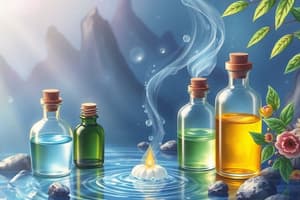Podcast
Questions and Answers
Describe the preparation of aromatic water and provide examples of aromatic waters and their uses.
Describe the preparation of aromatic water and provide examples of aromatic waters and their uses.
Aromatic waters are prepared by distillation, solution method, or alternate solution method. Examples include strong rose water, orange flower water, and concentrated peppermint water. They are mainly used as flavoring agents.
What are cachets and how are they prepared?
What are cachets and how are they prepared?
Cachets are solid dosage forms meant for oral administration of disagreeable drug substances. They are prepared by molding rice paper, a material made by pouring a mixture of rice flour and water between two hot polished revolving cylinders upon which water evaporates and a sheet of wafer is formed.
What is the purpose of using an inert adsorptive agent in the preparation of certain aromatic waters?
What is the purpose of using an inert adsorptive agent in the preparation of certain aromatic waters?
The inert adsorptive agent is used to thoroughly mix with volatile oil to prepare concentrated peppermint water. It helps in the agitated mixture and filtration process to obtain a clear filtrate.
Explain the process of preparing aromatic water using the alternate solution method.
Explain the process of preparing aromatic water using the alternate solution method.
What are the main uses of aromatic waters?
What are the main uses of aromatic waters?
Flashcards are hidden until you start studying
Study Notes
Preparation of Aromatic Water
- Aromatic waters are prepared by distilling water with plant materials, capturing volatile oils.
- The greatest purity is achieved using fresh or dried flowers, leaves, or fruits.
- The solution method involves dissolving the aromatic substances and filtering to obtain a clear liquid.
Examples of Aromatic Waters
- Rose Water: Used in cosmetics and skincare for its soothing properties.
- Lavender Water: Employed in aromatherapy and as a calming agent.
- Orange Blossom Water: Commonly used in desserts for flavoring and fragrance.
Cachets
- Cachets are small, sealed containers or envelopes used for delivering medicinal powders, often made with aromatic substances.
- Preparation involves mixing the powder with a binding agent, forming the cachets, and allowing them to dry.
Inert Adsorptive Agents
- Inert adsorptive agents (like activated charcoal or silica gel) help in stabilizing the aromatic components in waters.
- They prevent degradation and maintain the aromatic qualities during storage.
Alternate Solution Method for Aromatic Water
- The alternate solution method involves saturating water with aromatic oils while maintaining temperature controls.
- The process includes repeated cycles of mixing the oil with water, allowing sedimentation, and filtering the final solution for clarity.
Main Uses of Aromatic Waters
- Utilized in cosmetics for skin treatments and perfumes.
- Incorporated in culinary applications for flavoring and enhancing dishes.
- Commonly used in pharmacology for their therapeutic properties and as flavoring agents in medicines.
Studying That Suits You
Use AI to generate personalized quizzes and flashcards to suit your learning preferences.




